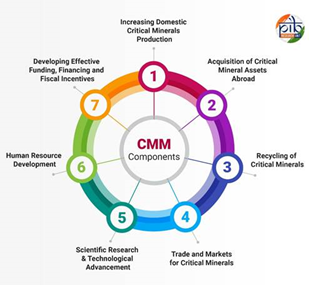Economy
Repo rate:
-
- Reserve Bank of India’s (RBI’s) six-member Monetary Policy Committee (MPC) April 9,2025, decided to cut the repo rate by 25 basis points to 6%.
- It also changed the monetary policy stance from “neutral” to “accommodative”, signaling further reductions in repo rate in the near future.
- Central bank’s decision comes amidst heightened global economic uncertainty in the face of far-reaching reciprocal tariffs announced by Donald Trump administration in US.
- Interest rate that RBI charges when commercial banks borrow money from it is called repo rate.
- Interest rate central bank pays commercial banks when they park their excess cash is called reverse repo rate.
- Repo rate is at 6% whereas reverse repo rate is at 3.35%.
- When RBI wants to encourage economic activity in economy, it reduces repo rates. This enables commercial banks to bring down interest rates they charge (on their loans) as well as interest rate they pay on deposits. This incentivises people to spend money, because keeping their savings in bank now pays back a little less, and businesses are incentivised to take new loans for new investments because new loans now cost little less as well.
- On the other hand, when RBI wants to control inflation, it increases the repo rate. Banks thus have to pay more interest to borrow from RBI, which means they will charge more interest to their borrowers. At a macro level, this inhibits people from borrowing money as well as from spending, which in turn reduces the amount of money in market and thus negates inflation.
Cape Town Convention:
-
- Parliament passed Protection of Interests in Aircraft Objects Bill, 2025.
- Proposed legislation establishes legal framework to resolve disputes between airlines and lessors over high-value aviation assets, such as aircraft, helicopters, and engines.
- Bill implements the Cape Town Convention and Protocol, which is an international treaty adopted by United Nations aviation watchdog, International Civil Aviation Organization (ICAO), in 2001 and signed by India in 2008.
- Cape Town Convention on International Interests in Mobile Equipment and its Aircraft Protocol were designed to create a uniform legal framework to facilitate asset-based financing and leasing of high-value mobile equipment like aircraft, helicopters & aircraft engines.
- India ratified Convention in 2008, but until now, had no domestic legislation to operationalize its provisions.
- Bill designates Directorate General of Civil Aviation (DGCA) as the Registry Authority for purposes of Convention. Such an authority is responsible for registration and de-registration of aircraft.
- Bill empowers DGCA to issue directions to implement
- It also defines remedies available in case of a default in payment that includes right to take back possession of asset within a period of two calendar months or a mutually agreed upon period, whichever is earlier.
- Bill will also have an overriding effect, which means that if there is any inconsistency between Bill and any other law, the provisions of Bill will prevail.
History, Art & Culture
Devgiri fort:
-
- Archaeological Survey of India (ASI) has initiated an investigation into a major fire that erupted at historic Devgiri Fort, also known as Daulatabad Fort, in Maharashtra’s Chhatrapati Sambhajinagar district.
- Fire has also significantly disrupted local wildlife & its habitat especially Peacocks.
- Built by Yadava King Bhillama V in 11th Century CE.
- It was Capital of Yadava rulers until end of 13th Century CE.
- Mohammad Bin Tughlak relocated his capital from Delhi to Devgiri in 14th Century CE and renamed it as Daulatabad.
- It houses Chand Minar, constructed by Ala-ud-din Bahmani in 1435 CE.
- It houses Aurangzeb’s Mendha canon.
Government Schemes
Modernisation of Command Area Development and Water Management (M-CADWM):
-
- It has been approved as a sub-scheme of Pradhan Mantri Krishi Sinchayee Yojana for period 2025-2026.
- Its key goal is to modernise irrigation water supply network, ensuring that water reaches designated farming clusters from existing canals or other water sources.
- In addition to modernising irrigation systems, the scheme aims to build sustainable farming practices in country.
- Use of SCADA (Supervisory Control and Data Acquisition), Internet of things technology will be used for water accounting and water management. This will increase the Water Use Efficiency (WUE) at farm level, increase agriculture production & productivity; and thereby increase income of farmers.
- Projects will be made sustainable by Irrigation Management Transfer (IMT) to Water User Society (WUS) for management of irrigation assets.
National Critical Mineral Mission (NCMM):
-
- Launched in 2025 to establish a robust framework for self-reliance in the critical mineral sector.
- Under this mission, Geological Survey of India (GSI) has been tasked with conducting 1,200 exploration projects from 2024-25 to 2030-31.
- A committee formed by Ministry of Mines in November 2022 identified 30 critical minerals, with 24 included in Part D of Schedule I of Mines and Minerals Development and Regulation Act, 1957 (MMDR Act, 1957).
- It means that Central Government now has exclusive authority to auction mining leases and composite licenses for these specific minerals.
- It also recommended setting up a Centre of Excellence on Critical Minerals (CECM) to regularly update mineral list and guide strategy.

Usage of Critical Minerals:
-
- Solar Energy: Critical minerals such as silicon, tellurium, indium, and gallium are vital for the production of photovoltaic (PV) cells used in solar panels.
- Wind Energy: Rare earth elements like dysprosium and neodymium are used in permanent magnets for wind turbines.
- Electric vehicles (EVs): Lithium, nickel, and cobalt are key materials used in lithium-ion batteries.
- Energy storage: Lithium-ion batteries used in advanced energy storage systems depend on lithium, cobalt, and nickel.
Geography
India Rare Earths Limited (IREL (India) Limited):
-
- It produces key minerals like ilmenite, rutile, zircon, sillimanite, and garnet.
- It operates a Rare Earth Extraction Plant in Chatrapur, Odisha and a Rare Earth Refining Unit at Aluva, Kerala.
- Ilmenite (FeO. TiO2) and rutile (TiO2) are the two chief minerals of titanium.
- Zircon is a zirconium silicate mineral (ZrSiO4). It is used in ceramic industry, Semi-precious and gemstones.
- Sillimanite or fibrolite is one of three aluminosilicate polymorphs, other two being andalusite and kyanite. Natural sillimanite is used in the manufacture of high alumina refractories or 55–60% alumina bricks.
- Garnets are a group of silicate minerals that have been used since the Bronze Age as gemstones and abrasives.
PRACTICE MCQs
Q1. The RBI led Monetary Policy Committee has recently reduced the Repo Rate. Which of the following can be its impact?
1. Increase in aggregate demand in the economy.
2. Bank credit gets costlier.
3. People will have more tendency to keep money in bank deposits.
Select the correct answer using the code given below:
a) 1 only
b) 1 and 2 only
c) 2 and 3 only
d) 1, 2 and 3
Answer: A
Q2. Consider the following pairs:
1. tellurium, indium, and gallium – vital to produce photovoltaic (PV) cells
2. dysprosium and neodymium – used in permanent magnets for wind turbines
3. lithium, nickel, and cobalt – used in electric vehicles and storage systems
How many of the above pairs are correctly matched?
a) Only one
b) Only two
c) All three
d) None
Answer: C
Q3. Cape Town Convention, recently seen in the news, is related to –
a) Financing and leasing of high-value mobile equipment like aircraft, helicopters & aircraft engines.
b) Global governance principles on regulation of Artificial Intelligence.
c) Setting standards for the e-waste management at national level.
d) Rehabilitation efforts for war affected people.
Answer: A
Q4. Consider the following statements about Devgiri fort:
1. It was built by Yadava King Bhillama V in 11th Century CE.
2. Mohammad Bin Tughlak relocated his capital from Delhi to Devgiri in 14th Century CE and renamed it as Daulatabad.
3. The fort complex houses Chand Minar, constructed by Ala-ud-din Bahmani.
Which of the statements given above is/are correct?
a) 1 and 2 only
b) 2 only
c) 2 and 3 only
d) 1, 2 and 3
Answer: D
Q5. Consider the following pairs of metals and their minerals:
1. Titanium – Ilmenite
2. Sillimanite – Silicon
3. Rutile – Radium
Which of the pairs given above are correctly matched?
a) 1 and 2 only
b) 2 and 3 only
c) 1 and 3 only
d) 1, 2 and 3
Answer: A
Download pdfSpread the Word

